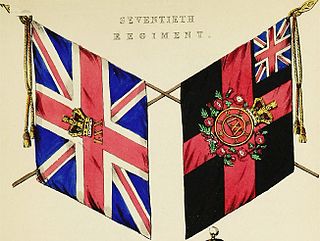
The 78th (Highlanders) Regiment of Foot was a Highland Infantry Regiment of the Line, raised in 1793. Under the Childers Reforms it amalgamated with 72nd Regiment, Duke of Albany's Own Highlanders to form the Seaforth Highlanders in 1881.
The 84th Regiment of Foot was a regiment in the British Army, raised in 1793. Under the Childers Reforms it amalgamated with the 65th Regiment of Foot to form the York and Lancaster Regiment, with the 84th becoming the 2nd Battalion, in 1881.

The 70th (Surrey) Regiment of Foot was a regiment of the British Army, raised in 1756. Under the Childers Reforms it amalgamated with the 31st (Huntingdonshire) Regiment of Foot to form the East Surrey Regiment in 1881.
The 91st Regiment of Foot was a Line Regiment of the British Army, raised in 1794. Under the Childers Reforms it amalgamated with the 93rd Regiment of Foot to form the Argyll and Sutherland Highlanders in 1881.
The 133rd (Highland) Regiment of Foot was a Scottish infantry regiment in the British Army, created in 1794 and disbanded in 1795. The regiment was raised in northern Scotland by Simon Fraser, and did not see any active service; it served solely to recruit soldiers. On disbandment, the recruits were drafted into other regiments.
The 69th Regiment of Foot was an infantry regiment of the British Army, raised in 1756. Under the Childers Reforms it amalgamated with the 41st (Welch) Regiment of Foot to form the Welch Regiment in 1881.
The 124th Regiment of Foot was an infantry regiment of the British Army, formed in 1794 and disbanded in 1795.

The 86th Regiment of Foot was an infantry regiment of the British Army, raised in 1793. Under the Childers Reforms it amalgamated with the 83rd Regiment of Foot to form the Royal Irish Rifles in 1881.
The 115th Regiment of Foot was an infantry regiment of the British Army from 1794 to 1795. It was raised in May 1794, named for its colonel Prince William Frederick, Duke of Gloucester and Edinburgh, but was disbanded the following year.
The 114th Regiment of Foot was an infantry regiment of the British Army from 1794 to 1795. It was raised in April 1794 and was disbanded the following year.
The 113th Regiment of Foot was an infantry regiment of the British Army from 1794 to 1795.
The 112th Regiment of Foot was an infantry regiment of the British Army from 1794 to 1795. It was raised in July 1794 and was disbanded in 1795.
The 110th Regiment of Foot was an infantry regiment of the British Army from 1794 to 1795.
The 109th (Aberdeenshire) Regiment of Foot was an infantry regiment of the British Army from 1794 to 1795. Raised by Alexander Leith Hay for service in the French Revolutionary Wars the regiment was briefly deployed in Jersey before it was disbanded in England and its men sent to reinforce the 53rd (Shropshire) Regiment of Foot. The disbandment was controversial as Leith-Hay believed it contravened an assurance given to him in his original letter of service to raise the regiment.
The 59th Regiment of Foot was an infantry regiment of the British Army, formed in 1755 in response to the threat of renewed war with France. Under the Childers Reforms it amalgamated with the 30th (Cambridgeshire) Regiment of Foot to form the East Lancashire Regiment in 1881.
The 107th Regiment of Foot was a short-lived infantry regiment of the British Army formed during the French Revolutionary Wars.
The 102nd Regiment of Foot was a short-lived regiment of the British Army raised in 1793 and disbanded in 1795.
The 23rd Light Dragoons was a cavalry regiment of the British Army which existed several times.
Major-General William Crosbie was a British Army officer.
The 105th Regiment of Foot had a brief existence as a British Army infantry regiment between 1794 and 1795. It was raised on 18 April 1794 in Leeds, Yorkshire, posted to Ireland and disbanded in 1795. Many of the personnel then transferred to other regiments. The Regimental Colonel throughout its life was Colonel Gordon Forbes.





